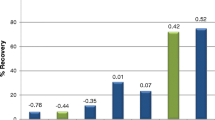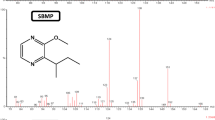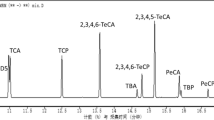Abstract
This study validates a new methodology which allows the direct quantification of 13 volatile aldehyde compounds related to oxidative off-flavours in wine. The compounds investigated were four (E)-2-alkenals ((E)-2-heptenal, (E)-2-hexenal, (E)-2-octenal and (E)-2-nonenal), four Strecker aldehydes (2-methylpropanal, 3-methylbutanal, methional and 2-phenylacetaldehyde) and five general aldehydes (hexanal, furfural, 5-methylfurfural, benzaldehyde and nonanal). This methodology involved the addition of p-benzoquinone to release the aldehydes bound to hydrogen sulfite, collection via solid phase extraction, derivatisation by o-(2,3,4,5,6-pentafluorobenzyl)hydroxylamine hydrochloride and quantification by gas chromatography triple-quadrupole mass spectrometer in multiple reaction monitoring mode. Overall, the limit of detection, limit of quantification, accuracy (recovery, 98–103%) and precision (repeatability and reproducibility, RSD ≤ 15%) are sufficient to enable routine measurement of the 13 aldehyde compounds in wine. Sixteen commercial white and red wines of varied varieties and vintages were analysed with this methodology. White wines trended to have higher concentrations of the aldehyde compounds in comparison with the red wines.



Similar content being viewed by others
References
Barbe J-C, de Revel G, Annick J, Lonvaud-Funel A, Bertrand A (2000) Role of carbonyl compounds in SO2 binding phenomena in musts and wines from botrytized grapes. J Agric Food Chem 48(8):3413–3419
Bueno M, Zapata J, Ferreira V (2014) Simultaneous determination of free and bonded forms of odor-active carbonyls in wine using a headspace solid phase microextraction strategy. J Chromatogr A 1369:33–42
Bueno M, Carrascón V, Ferreira V (2016) Release and formation of oxidation-related aldehydes during wine oxidation. J Agric Food Chem 64(3):608–617
Bueno M, Marrufo-Curtido A, Carrascón V, Fernández-Zurbano P, Escudero A, Ferreira V (2018) Formation and accumulation of acetaldehyde and Strecker aldehydes during red wine oxidation. Front Chem 6:1–19
Chira K, Pacella N, Jourdes M, Teissedre P-L (2011) Chemical and sensory evaluation of Bordeaux wines (cabernet-sauvignon and merlot) and correlation with wine age. Food Chem 126(4):1971–1977
Cruz MP, Valente IM, Gonçalves LM, Rodrigues JA, Barros AA (2012) Application of gas-diffusion microextraction to the analysis of free and bound acetaldehyde in wines by HPLC–UV and characterization of the extracted compounds by MS/MS detection. Anal Bioanal Chem 403(4):1031–1037
Culleré L, Cacho J, Ferreira V (2007) An assessment of the role played by some oxidation-related aldehydes in wine aroma. J Agric Food Chem 55(3):876–881
de Azevedo LC, Reis MM, Motta LF, da Rocha GO, Silva LA, de Andrade JB (2007) Evaluation of the formation and stability of hydroxyalkylsulfonic acids in wines. J Agric Food Chem 55(21):8670–8680
del Carmen Llaudy C, Canals MR, González-Manzano S, Canals JM, Santos-Buelga C, Zamora F (2006) Influence of micro-oxygenation treatment before oak aging on phenolic compounds composition, astringency, and color of red wine. J Agric Food Chem 54(12):4246–4252
Elias RJ, Laurie VF, Ebeler SE, Wong JW, Waterhouse AL (2008) Analysis of selected carbonyl oxidation products in wine by liquid chromatography with diode array detection. Anal Chim Acta 626(1):104–110
Escudero A, Hernández-Orte P, Cacho J, Ferreira V (2000) Clues about the role of methional as character impact odorant of some oxidized wines. J Agric Food Chem 48(9):4268–4272
Escudero A, Asensio E, Cacho J, Ferreira V (2002) Sensory and chemical changes of young white wines stored under oxygen. An assessment of the role played by aldehydes and some other important odorants. Food Chem 77(3):325–331
Ferreira V, Culleré L, Loscos N, Cacho J (2006) Critical aspects of the determination of pentafluorobenzyl derivatives of aldehydes by gas chromatography with electron-capture or mass spectrometric detection: validation of an optimized strategy for the determination of oxygen-related odor-active aldehydes in wine. J Chromatogr A 1122(1–2):255–265
Ferreira V, Bueno M, Franco-Luesma E (2015) New insights into the chemistry involved in aroma development during wine bottle aging: slow redox processes and chemical equilibrium shifts. In: Ebeler SB, Sacks G, Vidal S, Winterhalter P (eds) Advances in wine research, vol 1203. pp 275–289
Gambuti A, Rinaldi A, Ugliano M, Moio L (2013) Evolution of phenolic compounds and astringency during aging of red wine: effect of oxygen exposure before and after bottling. J Agric Food Chem 61(8):1618–1627
Han G, Wang H, Webb MR, Waterhouse AL (2015) A rapid, one step preparation for measuring selected free plus SO2-bound wine carbonyls by HPLC-DAD/MS. Talanta 134:596–602
Hofmann T, Schieberle P, Grosch W (1996) Model studies on the oxidative stability of odor-active thiols occurring in food flavors. J Agric Food Chem 44(1):251–255
Jackowetz JN, de Orduña RM (2013) Improved sample preparation and rapid UHPLC analysis of SO2 binding carbonyls in wine by derivatisation to 2,4-dinitrophenylhydrazine. Food Chem 139(1–4):100–104
Laurie VF, Clark AC (2010) Wine oxidation. In: Decker EA, Elias RJ, McClements DJ (eds) Oxidation in foods and beverages and antioxidant applications. Volume 2: Management in different industry sectors. Woodhead, Cambridge, pp 445–475
Mattivi F, Arapitsas P, Perenzoni D, Guella G (2015) Influence of storage conditions on the composition of red wines. Adv Wine Res Am Chem Soc 1203:29–49
Mayr CM, Capone DL, Pardon KH, Black CA, Pomeroy FIL (2015) Quantitative analysis by GC-MS/MS of 18 aroma compounds related to oxidative off-flavor in wines. J Agric Food Chem 63:3394–3401
Nikolantonaki M, Magiatis P, Waterhouse AL (2015) Direct analysis of free and sulfite-bound carbonyl compounds in wine by two-dimensional quantitative proton and carbon nuclear magnetic resonance spectroscopy. Anal Chem 87(21):10799–10806
Paixão N, Perestrelo R, Marques JC, Câmara JS (2007) Relationship between antioxidant capacity and total phenolic content of red, rosé and white wines. Food Chem 105(1):204–214
Pons A, Lavigne V, Darriet P, Dubourdieu D (2013) Role of 3-methyl-2,4-nonanedione in the flavor of aged red wines. J Agric Food Chem 61(30):7373–7380
Pripis-Nicolau L, de Revel G, Bertrand A, Maujean A (2000) Formation of flavor components by the reaction of amino acid and carbonyl compounds in mild conditions. J Agric Food Chem 48(9):3761–3766
Rizzi GP (2006) Formation of strecker aldehydes from polyphenol-derived quinones and α-amino acids in a nonenzymic model system. J Agric Food Chem 54(5):1893–1897
Silva Ferreira AC, Guedes de Pinho P, Rodrigues P, Hogg T (2002) Kinetics of oxidative degradation of white wines and how they are affected by selected technological parameters. J Agric Food Chem 50(21):5919–5924
Silva Ferreira AC, Hogg T, Guedes de Pinho P (2003) Identification of key odorants related to the typical aroma of oxidation-spoiled white wines. J Agric Food Chem 51(5):1377–1381
Singleton VL (1987) Oxygen with phenols and related reactions in musts, wines, and model systems: observations and practical implications. Am J Enol Vitic 38(1):69–77
Slegers A, Angers P, Ouellet E, Truchon T, Pedneault K (2015) Volatile compounds from grape skin, juice and wine from five interspecific hybrid grape cultivars grown in Quebec (Canada) for wine production. Molecules 20:10980–11016
Ugliano M (2013) Oxygen contribution to wine aroma evolution during bottle aging. J Agric Food Chem 61(26):6125–6136
Vivar-Quintana AM, Santos-Buelga C, Francia-Aricha E, Rivas-Gonzalo JC (1999) Formation of anthocyanin-derived pigments in experimental red wines / Formación de pigmentos derivados de antocianos en vinos tintos experimentales. Food Sci Technol Int 5(4):347–352
Wildenradt HL, Singleton VL (1974) The production of aldehydes as a result of oxidation of polyphenolic compounds and its relation to wine aging. Am J Enol Vitic 25(2):119–126
Wirth J, Morel-Salmi C, Souquet JM, Dieval JB, Aagaard O, Vidal S, Fulcrand H, Cheynier V (2010) The impact of oxygen exposure before and after bottling on the polyphenolic composition of red wines. Food Chem 123(1):107–116
Acknowledgements
This work was conducted as part of a PhD program at the National Wine and Grape Industry Centre (NWGIC) supported by a Charles Sturt University Postgraduate Research Scholarship and an International Tuition Payment scholarship. Further stipend and operating support was provided by Wine Australia (AGW Ph1509). The NWGIC is a research centre within CSU in alliance with the Department of Primary Industries New South Wales (NSW) and the NSW Wine Industry Association.
Funding
This study was funded by Wine Australia (AGW Ph1509) and Charles Sturt University Postgraduate Research Scholarship and an International Tuition Payment scholarship.
Author information
Authors and Affiliations
Corresponding author
Ethics declarations
Conflict of Interest
Xinyi Zhang declares that she has no conflict of interest. Nikolaos Kontoudakis declares that he has no conflict of interest. John Blackman declares that he has no conflict of interest. Katja Šuklje declares that she has no conflict of interest. Guillaume Antalick declares that he has no conflict of interest. Andrew Clark declares that he has no conflict of interest.
Research Involving Human Participants and/or Animals
This article does not contain any studies with human participants or animals performed by any of the authors.
Additional information
Publisher’s Note
Springer Nature remains neutral with regard to jurisdictional claims in published maps and institutional affiliations.
Rights and permissions
About this article
Cite this article
Zhang, X., Kontoudakis, N., Blackman, J. et al. Determination of 13 Volatile Aldehyde Compounds in Wine by GC-QQQ-MS: p-Benzoquinone to Dissociate Hydrogen Sulfite Addition Products. Food Anal. Methods 12, 1285–1297 (2019). https://doi.org/10.1007/s12161-019-01463-1
Received:
Accepted:
Published:
Issue Date:
DOI: https://doi.org/10.1007/s12161-019-01463-1




